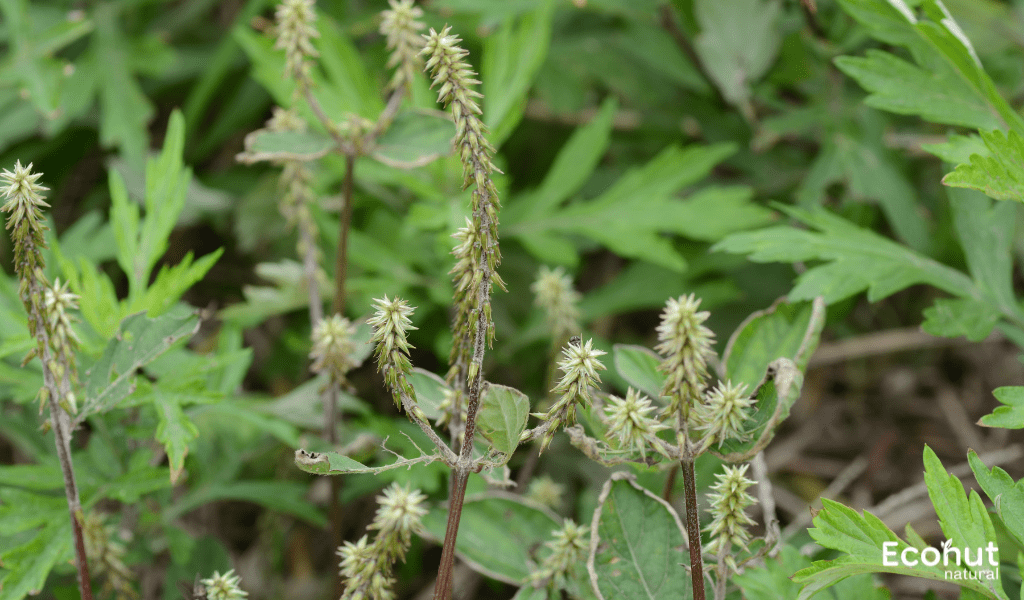Apamarg (Achyranthes Aspera), often referred to as “Prickly chaff flower,” is an erect, stiff, annual-perennial plant that is typically found in waste areas, roadsides, gardens, fields, farms, forest borders, forest clearings, and other locations.
Apamarga (Achyranthes Aspera) frequently has a woody base. The plant known as “Apamarga” is said to alleviate all three vitiated doshas. The word “aspera” refers to the spiny bracts of the prickly chaff flower plant’s inflorescence, and the word “achyranthes” denotes a plant with many thorns.Apamarga’s wide range of effects and capacity to balance all three doshas make it one of the most significant and often utilized herbs in Ayurveda. Thus, it is frequently used to treat a variety of illnesses, including allergic reactions.
Description
Achyranthes aspera been highly valued in Ayurvedic scriptures even revered Ayurvedic books like the Charaka Samhita dedicate a whole chapter to the plant “Apamarg Tanduliya,” listing all the various ways it can be utilized to treat human ailments.
Botanical Name:
Achyranthes Aspera
Family:
Amaranthaceae
Leaves:
Thick, whole, obtuse, elliptic, or obovate leaves
Flowers:
Flowers Small, many, stiffly deflexed against the rachis, greenish-white flowers are arranged on an extended terminal spike.
Habitat:
It is found all throughout the tropical world. It is a common weed and an invasive plant that grows in numerous places. In certain regions, such as several of the Pacific Islands, it is an invasive species.
Parts Used:
- Roots
- Panchang
- Seeds
- Leaf
Dosage:
- Juice – 5 – 10ml
- Apamarg kshara oil – 1-3 drops
- Kshara – 0.5 to 2 g
Chemical Constituents
Chemically, Achyranthes aspera is composed of Triterpenoid saponins that have been shown to contain oleanolic acid , ecdysterone, long chain alcohol, 17-penta triacontanol, aglycone A, B, C, and D, as well as isolated enzyme levels.
Types of Apamarg
- Red Apamarg (rakta) – Puppalia lappaceae
- White Apamarg (shweta) – Achyranthes aspera
Other Language Names of Apamarg (Achyranthes Aspera)
Punjabi name – Puthakanda, Kutri
Marathi name – Aghada, Pandhara-aghada
Spanish name – Cadillo chichoborugo, mazotillo
Kinihi, Shikhari, Adhah Shalya, Khara manjari, kubja, vasheera, Durabhi graha, Duragraha
Kannada name – Uttrani, Uttarani
English name – Prickly Chaff flower
Hindi name – Chirchita, Chirchira, Latjira, Chingchingi, Onga
Sanskrit name – Markati, Markat, Kapi pippali, Parak pushpin, Pratyaka shreni, Mayuraka,
Indonesia name – Jarong
French name – Herbe à Bengalis, herbe sergen, queue de rat
Telugu name – Antisha, Apamargamu, Uttaraene
Malayalam name – Katalati, Kadaladi
Bengali name – Apang
Malagasy name – Mahabaka
Tamil name – Shiru kadaladi, Nayuruvi
Sinhala name -Karal heba
African name – Grootklits, Langklitskablom
Scientific Classification
| Kingdom | Plantae |
| Order | Caryophyllales |
| Family | Amaranthaceae |
Ayurvedic Properties
Hindi/Sanskrit
- Rasa -Katu,Tikta
- Guna -Laghu,Ruksha,Tikshna
- Virya -Ushna
- Vipaka -Katu
English
- Taste -Pungent, Bitter
- Physical Property-Light, Dry,Sharp
- Potency- Hot
- Metabolic Property (After Digestion)-Pungent
Apamarg (Achyranthes Aspera) Uses
- The pulp of fresh Achyranthens Aspera leaves and flowering spikes is a potent home cure for scorpion bites.
- Hydrophobia is treated with flowering, elongated spikes mixed with a small amount of sugar in cases of mad dog bites.
- Supplements containing Achyranthens Aspera plant help reduce extra body fat by preventing belly fat from accumulating; the gluteal areas regulate body weight.
- Achyranthens Aspera’s fruits and flowers can be used to treat menorrhagia.
Apamarg (Achyranthes Aspera) Benefits
Apamarga is good for your heart:
Apamarga is regarded as a Hridya in Ayurveda. By removing the cholesterol deposits that accumulate on the heart and impede blood flow, it helps to enhance heart health. It also improves the function of the heart.
Cough and Cold:
Because of its Ushna virya nature, Apamarga Kshar, also known as amamalga ash, is a powerful and effective remedy for clearing the body of excess Kapha and providing relief from coughing.
Earache:
Because apanarg kshar oil balances Vata, it is utilized to lessen earaches.
Eye problem, redness in eye:
Take a fresh Apamarg root and give it a thorough cleaning to get rid of any dirt. To treat an eye infection, grind it with rose water and apply it to the eyes.
Respiratory Health:
It is highly regarded by many because of its capacity to support respiratory health. It is commonly used in Ayurvedic formulations to treat respiratory conditions and improve clarity of breathing.
Skin Care:
The antibacterial and anti-inflammatory qualities of the herb also apply to skincare. Oils and lotions with amamarg extract are used to relieve skin irritations and support a healthy complexion.
Controls hunger:
The Apamarga tree helps balance the body’s vata and kapha doshas. This plant can be used to treat conditions where an insatiable appetite is one of the symptoms. Make the patient some Apamarg porridge and serve it. They will recover from their illness soon. You can also digest the “ama” in your body, which is the unprocessed food in your gastrointestinal tract.
Indigestion:
Because of Achyranthes aspera’s superior Deepan (appetiser) and Pachan (digestive) qualities, it strengthens the digestive system and lowers Ama levels in the body.
Don’t miss: Shatapushpa, Dill Seeds (Anethum Graveolens) How to Use, Benefits, Properties & Side Effects
Apamarg (Achyranthes Aspera) Side Effects
Gastrointestinal issues:
Diarrhea, vomiting, and nausea might result from high dosages of Apamarg.
Skin irritation:
When applied topically, especially over prolonged periods of time, Apamarg paste may cause rashes or irritation of the skin. Mixing the paste with coolants such as milk or ice can help reduce this risk.
Pregnancy and Breastfeeding:
For women who are pregnant or nursing, Apamarg is not advised due to a lack of safety data.
Conclusion
In India, Achyranthes aspera is a traditional and vital medicinal herb or weed. Traditional medicines are made from nearly every part of Achyranthes aspera, including the seeds, roots, and shoots. The plant Achyranthes Aspera is highly valued by traditional healers. Boils, asthma, helping with childbirth, bleeding, bronchitis, debility, dropsy, cold, colic, cough, dog bite, snake bite, scorpion bite, dysentery, earache, headache, leukoderma, renal problems, pneumonia, and skin illnesses are among the conditions for which Achyranthes Aspera is used.
FAQS
For what purpose is Achyranthes aspera used?
Ayurveda has long utilized apamarga as an anti-inflammatory, in addition to its usage in treating hemorrhoids, dyspepsia, cough, asthma, anemia, jaundice, and snake bites. Locally, earaches are treated using apararg oil. When treating skin conditions, the powdered root is applied to the lesion.
What is the scientific name for Apamarg?
Achyranthes Aspera
What advantages does Achyranthes have for health?
Achyranthens Aspera juice is administered on ulcers and wounds to promote faster healing because of its ropan (astringent) and anti-inflammatory effects. When applied topically, Achyranthens Aspera root paste and juice relieve pain; alleviate itching, skin rashes from bug bites, and urticaria. They are also beneficial for treating earaches.
What negative impacts might Achyranthes root cause?
Larger doses of Achyranthes aspera can induce nausea and vomiting, thus it is best to take it for the specified length of time and quantity. Men using fertility therapy shouldn’t use it for an extended period of time.

